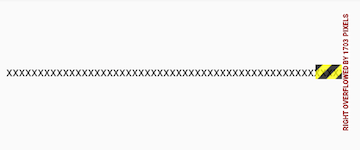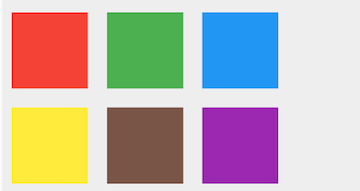在介绍Row和Colum时,如果子widget超出屏幕范围,则会报溢出错误,如:
Row(children: <Widget>[Text("xxx"*100)],);
运行效果如图所示:
可以看到,右边溢出部分报错。这是因为Row默认只有一行,字体太长没有折行导致超出屏幕。
我们把超出屏幕显示范围会自动折行的布局称为流式布局。Flutter中通过Wrap和Flow来支持流式布局,将上例中的Row换成Wrap后溢出部分则会自动折行,下面我们分别介绍Wrap和Flow.
Wrap
Wrap的定义:
(new) Wrap Wrap({Key key,Axis direction = Axis.horizontal,WrapAlignment alignment = WrapAlignment.start,double spacing = 0.0,WrapAlignment runAlignment = WrapAlignment.start,double runSpacing = 0.0,WrapCrossAlignment crossAxisAlignment = WrapCrossAlignment.start,TextDirection textDirection,VerticalDirection verticalDirection = VerticalDirection.down,List<Widget> children = const <Widget>[]})
我们可以看到Wrap的很多属性在Flex(包括Row和Column))中也有,如:
- direction、
- crossAxisAlignment、
- textDirection、
- verticalDirection等,这些参数意义是相同的
读者可以认为Wrap和Flex(包括Row和Column)除了超出显示范围后Wrap会折行外,其它行为基本相同。下面我们看一下Wrap特有的几个属性:
- spacing:主轴方向子widget的间距
- alignment:主轴上的对齐方式
- runSpacing:纵轴方向的间距
- runAlignment:纵轴方向的对齐方式
下面看一个示例子:
import 'package:flutter/material.dart';void main() => runApp(new MyApp());class MyApp extends StatelessWidget {@overrideWidget build(BuildContext context) {return MaterialApp(debugShowCheckedModeBanner: false,title: 'Warp 流体布局',theme: ThemeData(primarySwatch: Colors.blue,),home: Scaffold(appBar: AppBar(title: Text("Warp 流体布局")),body: FlexLayoutTestRoute()));}}class FlexLayoutTestRoute extends StatelessWidget {@overrideWidget build(BuildContext context) {return Wrap(spacing: 8.0, // 主轴(水平)方向间距runSpacing: 4.0, // 纵轴(垂直)方向间距alignment: WrapAlignment.center, //沿主轴方向居中children: <Widget>[new Chip(avatar:new CircleAvatar(backgroundColor: Colors.blue, child: Text('A')),label: new Text('Hamilton'),),new Chip(avatar:new CircleAvatar(backgroundColor: Colors.blue, child: Text('M')),label: new Text('Lafayette'),),new Chip(avatar:new CircleAvatar(backgroundColor: Colors.blue, child: Text('H')),label: new Text('Mulligan'),),new Chip(avatar:new CircleAvatar(backgroundColor: Colors.blue, child: Text('J')),label: new Text('Laurens'),),],);}}

Chip参数属性
(new) Chip Chip({Key key,
Widget avatar,
Widget label,
TextStyle labelStyle,
EdgeInsetsGeometry labelPadding,
Widget deleteIcon,
void Function() onDeleted,
Color deleteIconColor,
String deleteButtonTooltipMessage,
ShapeBorder shape,
Clip clipBehavior = Clip.none,
FocusNode focusNode,
bool autofocus = false,
Color backgroundColor,
EdgeInsetsGeometry padding,
MaterialTapTargetSize materialTapTargetSize,
double elevation,
Color shadowColor})
CircleAvatar参数属性
CircleAvatar CircleAvatar({Key key,
Widget child,
Color backgroundColor,
ImageProvider<dynamic> backgroundImage,
Color foregroundColor,
double radius,
double minRadius,
double maxRadius})
Flow
我们一般很少会使用Flow,因为其过于复杂,需要自己实现子widget的位置转换,在很多场景下首先要考虑的是Wrap是否满足需求。Flow主要用于一些需要自定义布局策略或性能要求较高(如动画中)的场景。Flow有如下优点:
Flow参数属性
(new) Flow Flow({Key key, FlowDelegate delegate, List<Widget> children = const <Widget>[]})
- 性能好Flow是一个对子组件尺寸以及位置调整非常高效的控件,Flow用转换矩阵在对子组件进行位置调整的时候进行了优化:
- 在Flow定位过后,如果子组件的尺寸或者位置发生了变化,在FlowDelegate中重写paintChildren()方法
- 在paintChildren()方法中调用context.paintChild进行重绘,而context.paintChild在重绘时使用了转换矩阵,并没有实际调整组件位置。
- 灵活由于我们需要自己实现delegate属性中FlowDelegate的paintChildren()方法,所以我们需要自己计算每一个组件的位置,因此,可以自定义布局策略。
缺点:
- 使用复杂。
- 不能自适应子组件大小,必须通过指定父容器大小或实现FlowDelegate的getSize返回固定大小。
我们对六个色块进行自定义流式布局:
import 'package:flutter/material.dart';
void main() => runApp(new MyApp());
class MyApp extends StatelessWidget {
@override
Widget build(BuildContext context) {
return MaterialApp(
debugShowCheckedModeBanner: false,
title: 'Flow自定义流式布局',
theme: ThemeData(
primarySwatch: Colors.blue,
),
home: Scaffold(
appBar: AppBar(title: Text("Flow自定义流式布局")),
body: FlexLayoutTestRoute()));
}
}
class FlexLayoutTestRoute extends StatelessWidget {
@override
Widget build(BuildContext context) {
return Flow(
delegate: TestFlowDelegate(margin: EdgeInsets.all(1.0)),
children: <Widget>[
new Container(
width: 80.0,
height: 80.0,
color: Colors.red,
),
new Container(
width: 80.0,
height: 80.0,
color: Colors.green,
),
new Container(
width: 80.0,
height: 80.0,
color: Colors.blue,
),
new Container(
width: 80.0,
height: 80.0,
color: Colors.yellow,
),
new Container(
width: 80.0,
height: 80.0,
color: Colors.brown,
),
new Container(
width: 80.0,
height: 80.0,
color: Colors.purple,
),
],
);
}
}
//继承FlowDelegate实现TestFlowDelegate,重绘
class TestFlowDelegate extends FlowDelegate {
// EdgeInsets margin = EdgeInsets.zero;
EdgeInsets margin;
TestFlowDelegate({this.margin = EdgeInsets.zero});
@override
void paintChildren(FlowPaintingContext context) {
var x = margin.left;
var y = margin.top;
//计算每一个子widget的位置
for (int i = 0; i < context.childCount; i++) {
var w = context.getChildSize(i).width + x + margin.right;
if (w < context.size.width) {
context.paintChild(i,
transform: new Matrix4.translationValues(x, y, 0.0));
x = w + margin.left;
} else {
x = margin.left;
y += context.getChildSize(i).height + margin.top + margin.bottom;
//绘制子widget(有优化)
context.paintChild(i,
transform: new Matrix4.translationValues(x, y, 0.0));
x += context.getChildSize(i).width + margin.left + margin.right;
}
}
}
@override
getSize(BoxConstraints constraints) {
//指定Flow的大小
return Size(double.infinity, 200.0);
}
@override
bool shouldRepaint(FlowDelegate oldDelegate) {
return oldDelegate != this;
}
}

可以看到我们主要的任务就是实现paintChildren,它的主要任务是确定每个子widget位置。由于Flow不能自适应子widget的大小,我们通过在getSize返回一个固定大小来指定Flow的大小。

